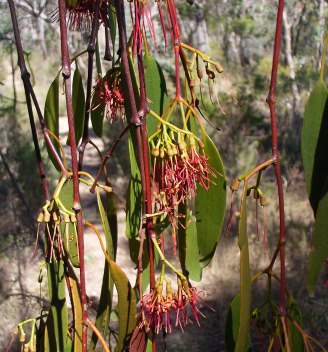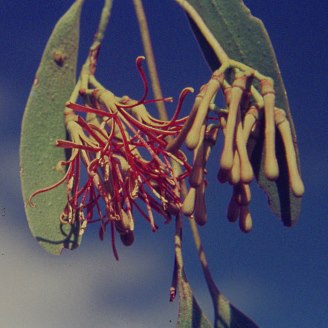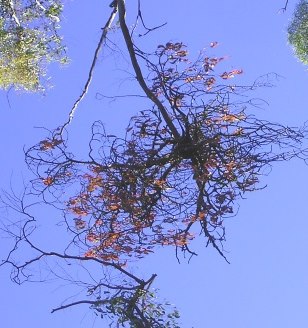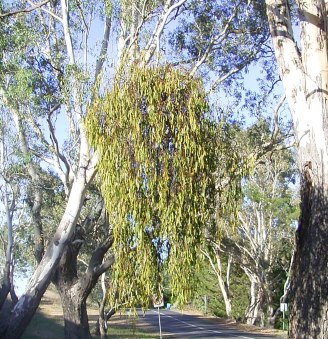Plants of the Castlemaine District.
Box Mistletoe - native (Amyema miquelii)
Home.....
Menu.....
Common name index.....
Scientific name index.....
Glossary .....
Other mistletoes

Family: Loranthaceae (Mistletoe family).
It is by far the most common mistletoe in the Box Ironbark forests and Heathy Dry forests where it mostly grows on Red Stringybark, the box eucalypts, Yellow Gum and Red Ironbark.
It is a hemi-parasite; it relies on the host plant for water and minerals, but has chlorophyll and is able to make its own sugars and other carbohydrates.
Identification:
- the flowers are red
- the flowers are in groups of three; the central flower is stalked
- the leaves and branchlets are a shiny red-green.
- all of the flowers of Box Mistletoe are stalked (The central flower of Drooping Mistletoe is stalkless.)
- the branchlets of Box Mistletoe are shiny (Dull brown in Drooping Mistletoe.)
- Box Mistletoe flowers in autumn (Spring for Drooping Mistletoe.)
- Box Mistletoe grows mostly on Box eucalypts, Red Stringybark, Yellow Gum and Red Ironbark. (Drooping Mistletoe grows on other eucalpts or wattles.)
Name: miquelii: after Friedrich Miquel, a dutch botanist and an authority on mistletoes.
Photos 1, 2: Box Mistletoe. Castlemaine. 3: Trees are able to kill off mistletoes by cutting off the flow of sap to the mistletoe. The rest of the eucalypt branch also dies.
4: Tear-drop shaped clump of Box Mistletoe on a Red Gum. Downes Road, Castlemaine. It is uncommomn to find Box Mistletoe on Red Gums.
4: Tear-drop shaped clump of Box Mistletoe on a Red Gum. Downes Road, Castlemaine. It is uncommomn to find Box Mistletoe on Red Gums.


